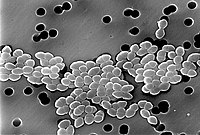
Photo from wikipedia
OBJECTIVE To determine whether discontinuing active screening for vancomycin-resistant Enterococcus (VRE) in Alberta, Canada, acute-care facilities had an associated impact on the rate of rise of hospital-acquired (HA) VRE bloodstream… Click to show full abstract
OBJECTIVE To determine whether discontinuing active screening for vancomycin-resistant Enterococcus (VRE) in Alberta, Canada, acute-care facilities had an associated impact on the rate of rise of hospital-acquired (HA) VRE bloodstream infection (VRE-BSI). SETTING Acute-care facilities in Alberta, Canada. PATIENTS All patients who were admitted to Alberta Health Services or Covenant Health acute-care facilities between January 1, 2013, and March 31, 2020, and who met the definition for hospital-acquired VRE-BSI were included in the analyses. METHODS An intervention time-series Poisson regression was used to determine the slope change in VRE incidence between the pre- and postintervention (screening) periods. The patient population was separated into 3 cohorts: group 1 (low risk, VRE screening stopped), group 2 (high risk, VRE screening stopped), and group 3 (high risk, VRE screening continued). For all groups, a level- and slope-change model was used. RESULTS We did not find a statistically significant difference in the slope change or rate of rise in VRE-BSI before and after the intervention, with incidence rate ratio (IRRs) of 1.015 (95% confidence interval [CI], 0.982-1.049), 1.025 (95% CI, 0.967-1.086), and 0.989 (95% CI, 0.924-1.059) for groups 1, 2 and 3, respectively. CONCLUSIONS In Alberta, the rate of HA VRE-BSI has remained consistent, and our findings indicate that there has been no increase in the rate of rise of HA VRE-BSI in sites or units that discontinued screening for VRE, regardless of patient risk group.
Journal Title: Infection control and hospital epidemiology
Year Published: 2022
Link to full text (if available)
Share on Social Media: Sign Up to like & get
recommendations!